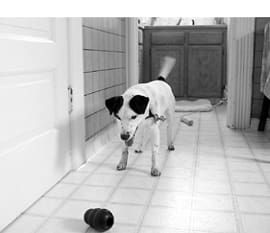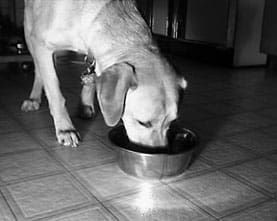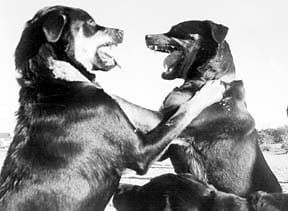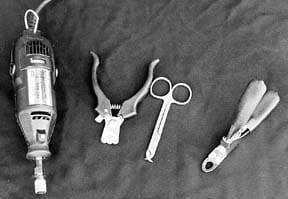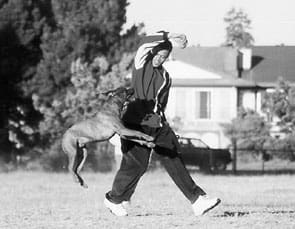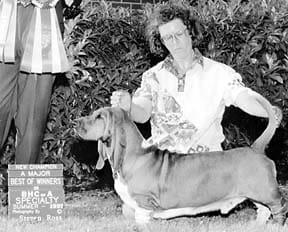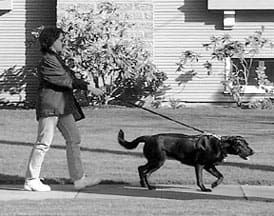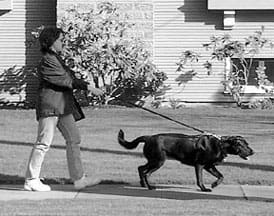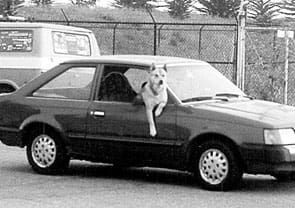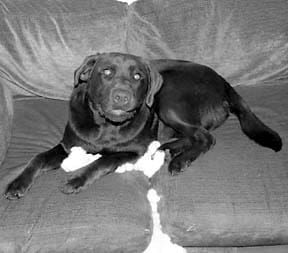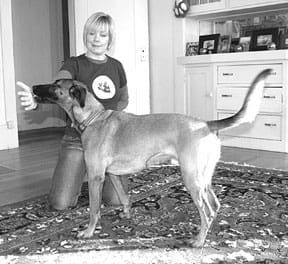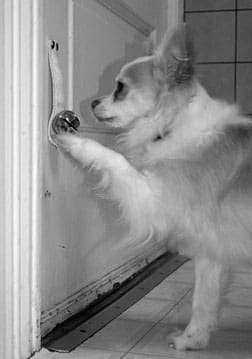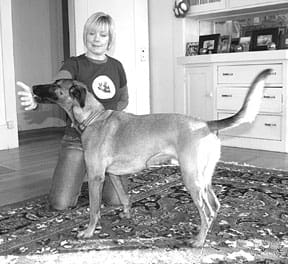For many years, I have been a vigorous and vocal opponent of keeping dogs tied or chained as a primary means of confinement. The hazards of tying a dog are well-documented, and include increased aggression, vulerability to human and non-human intruders, and the risk of hanging or choking.
It may come as a surprise, therefore, to know that I regard the tether as an invaluable piece of training equipment. The difference – and it’s a big one – is in the application.
Used as a training tool, the tether is a short (about four feet in length) nylon-coated cable with sturdy snaps at both ends. Its purpose is to temporarily restrain a dog for relatively short periods of time in your presence, to allow you to accomplish any one of a number of training and behavior modification goals. It is not used as punishment, or to restrain a dog for long periods in your absence.
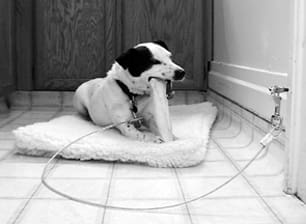
Among other things, the tether can be used as a time-out to settle unruly behavior; to teach your dog to sit politely to greet people; as an aid in a puppy supervision and housetraining program; and to help your dog learn long-distance downs. There are several different ways to set up your tether, depending on your circumstances (see “It’s Easy To Make A Tether” below). Let’s take a look at how you might use the tether in each of the situations listed above.
How to Start Using the Tether with Your Dog
You want your dog’s time on the tether to be a pleasant experience. Before you actually use it the first time for training purposes, take the time to teach him that it is a good place to be, so he doesn’t panic when you try to use it.
Start by attaching his collar to the tether and staying with him. Click! or say “Yes!” and feed him treats, several times. If he knows the “sit” cue, ask him to sit and Click! and treat him some more. Then take a step back, Click! and return to give him a treat.
Gradually vary the distance and length of time between each set of clicks and treats, until he is calm and comfortable on the tether even if you are across the room. If he seems worried about being on the tether, keep your session brief and try to do several short sessions a day until he accepts the restraint.
Release him from the tether when he is most calm, not when he is fretting. If the tether doesn’t worry him, one or two practice sessions should be all you need to start using it in training.
Using A Tether for Dog Time-Outs
Rowdy, your adolescent Lab, is out of control. He’s not supposed to get on the furniture, but every time you sit on the sofa he tries to jump in your lap. If you push him off your lap he just comes back for more; in fact, he thinks it’s a great game. Rowdy needs to learn about “Time Out!”
A time-out is not intended to be a harsh punishment. It is simply an opportunity for Rowdy to calm down, and to learn that his rambunctious behavior results in his house-freedom privileges getting revoked for a while. Believe it or not, with the use of a tether, he can learn to control his own behavior in order to maintain his freedom.
Install a tether in the room of the house where you spend the most time – or have several, one in each of your high-use areas. Put a rug or soft dog bed at each tether, so Rowdy will be comfortable. Have a few of his favorite toys handy so you can give him one when you put him on a time out.
Now just sit down on the sofa, and wait. When Rowdy jumps into your lap, say “Oops, time out!” in a cheerful tone of voice. Then take hold of his collar and gently lead him to the tether. Be pleasant – no scolding or yelling. Hook the tether to his collar, put his toys on the rug, and walk away. If he fusses, ignore him.
When he settles and is lying calmly on his rug, you can Click! your clicker or say Yes! and either toss him a treat or walk over and give him one. After a few Clicks! and treats for calm behavior, release him from the tether and sit on the sofa again. If he jumps up, do another “Oops, time out!” and pleasantly put him back on his tether.
The number of repetitions required to get the message across to Rowdy will vary, depending on you and your dog. If he has a long history of reinforcement for jumping on your lap – that is, if he has been playing the lap game with you for years – it will take longer to change his behavior than if he’s only been doing it for a few days, weeks, or months.
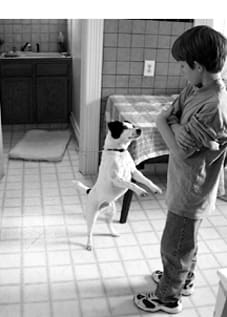
Also, if you (or other members of your family) are not consistent about putting him on a time-out for every lap-jump, the behavior will persist much longer than if everyone reacts in the same way.
Dogs learn through repetition, so if he continues to jump on you after you release him from the tether, just “Oops, time out!” him again, put him back on the tether, and consider it a golden opportunity to do lots of training repetitions.
The timing of your Click! is important because it marks the good behavior; you want your dog to know he’s getting rewarded for whatever he was doing when he heard the Click! The timing of your “Oops!” is also important. The “Oops!” should happen while Rowdy is doing the inappropriate behavior, not when you are attaching him to the tether, so that he can eventually understand which behavior has earned him the time out.
Putting a dog in the back yard when he misbehaves is not as effective as using a tether, because most owners forget to let the dog back inside when he’s behaving himself. If you expect him to learn how to be well-behaved, it is important to give him the chance to be rewarded for the behavior you want (being calm), and not just manage the behavior you don’t want by exiling him from the pack.
Teaching Dogs to Greet Politely
Jumping up on people is a natural behavior for dogs. It’s also a very annoying one. Dogs just want to greet you and have you greet them back. They quickly learn that people invariably pay attention to them when they jump up, so they keep doing it – remember, dogs do what works.
You can use the tether to teach Rowdy that people pay attention to him only when he sits. If he learns that jumping up doesn’t work, he’ll stop doing it.
Start by practicing with family members. Put Rowdy on the tether and take several steps back. Now walk toward him. If he jumps up, stop out of his reach and wait for him to sit. If you have been clicker-training him, this should happen fairly quickly.
When he sits, move forward again. If he jumps up, stop, and wait for him to sit. Continue until you are standing in front of him and he is sitting in front of you. Click! and feed him a treat. Now do it again, until you can walk right up to him without having him jump up. (If he jumps up when you offer the treat, whisk it away behind your back, wait for him to sit, and offer it again. Several disappearing treats should convince him to sit patiently until you get it to his mouth.)
As soon as Rowdy will sit for your approach, add other people to the game – family members, friends, and anyone else you can convince to participate. Set up a tether near your front door for a handy place to attach your dog when you greet visitors. This will help you teach him to greet people calmly at the door at the same time.
You can make use of your leash for the same purpose as the tether when you are walking your dog in public. When anyone wants to pet him, tell them Rowdy is in training and you need their help. Explain that they can pet Rowdy and feed him a treat as soon as he sits. This way, Rowdy will learn that the “Sit” game works for all humans, not just the ones in his pack or at home in his den.
Puppy Supervision
The biggest mistake most new puppy owners make is giving baby Rowdy too much freedom, too soon. They spend much of their day two steps behind their darling little dynamo, cleaning up the destruction and doggie-doo. Rowdy gets to practice all kinds of rewarding inappropriate behaviors, such as house soiling, raiding garbage cans, counter-surfing, chewing human possessions, and playing a wonderful game of keep-away when humans try to get their possessions back.
This is the time in Rowdy’s life when it is most important to practice behavior management. Along with a crate and a puppy-pen, a wisely-used tether can take much of the pain out of puppyhood. The portable “under-the-door” tether is perfect for this application, as you can take it with you into any room, not just those that are set up for wall tethers. Since puppy teeth tend to find furniture particularly inviting, attaching the tether to the piano or coffee table leg isn’t a great idea either. You can slip the portable tether under a door, close it, and keep Rowdy close at hand instead of worrying about whether he’s peeing on – or chewing up – the Oriental rug.
Dog Training from a Distance
Tethers are not just for basic good manners training. Once Rowdy has learned house manners, you can also use your tether to teach him to respond to your cues from a distance.
In basic training you probably taught Rowdy to sit and lie down right next to your side, or directly in front, facing you. Rowdy now thinks that “Down” means “lie down next to my human.” If he’s on the other side of the room and you ask him to lie down, he comes to you and then drops to the ground. Darn. You wanted him to lie down on his rug on the other side of the room. How hard is that for Rowdy to figure out?! Remember that your dog is only doing what he thinks he’s supposed to do. Don’t get mad, get training. Using a tether, it’s simple to show Rowdy that “Down” means “down wherever you are.”
First, you need a good response from your dog to a verbal “down” cue. If you don’t have it yet, go back to his basic training. You want him to lie down for you on just the word cue, without having to point toward the ground or lure him down. When he will do that, attach him to the tether, face him, and ask him to down. Click! and reward when he lies down. Then invite him back to a sit and take a step back. Ask him to down again. If he steps toward you, let the tether restrain him, and just wait. If he doesn’t down after several seconds, lure him down. Click! and reward.
Stay in that same spot until he will down on the verbal cue from one step away. Now take another step back and try it again. Lure if necessary, Click! and reward when he does it. Continue to repeat the exercise at each new distance until he responds to your verbal cue. Then take another step away, until he will do a distance down on the tether from across the room or the yard. Then try it off the tether, again starting with a short distance, gradually moving farther and farther away as he understands what you are asking him to do.
Some dogs can do this in one training session, others take several. Remember to keep your sessions short, and to stop training while you and your dog are both enjoying the game. If one or both of you are getting frustrated or bored, stop, do something easy and fun, and take a break.
It’s Easy to Make A Tether
A tether is a simple, four-foot length of nylon-coated cable with sturdy snaps on both ends. Most of the cables available commercially are intended for tying a dog outside, and are a minimum of 10 feet. That is too long for most training purposes.
[Editor’s Note: Against Miller’s advice, we bought a 10-foot model, thinking we could cut it in half and make two tethers. Our test dog broke the commercial product’s hardware in about two minutes. Then we read the package’s warning that the product wasn’t made “to be used as a restraining device.” Oh!]
Fortunately, it’s easy to make your own training tether, or ask your local hardware store if they will attach the snaps to the ends of a four-foot cable for you with the necessary ferrules (the metal hardware used to hold the cable) and a crimping tool.
Take a four-foot length of 1/8-inch nylon-coated cable. Thread one end through one channel of the appropriate-size ferrule, then through the ring of a small but sturdy metal clip. Fold the cable back on itself, run it through the other channel of the ferrule, and crimp the ferrule on both pieces of cable to hold the end in place. Repeat with the other end. You now have the basic tether.
[Editor’s Note: We found the price of a crimping tool to be restrictive; we used a hammer to crimp the ferrules.]
Next, screw an eye-bolt into a stud or beam, or other solid piece of wood in your home (or put eye-bolts in several locations) that are sturdy enough to withstand your dog’s weight if he pulls on the tether with his full weight. Snap one end of the tether to the eye-bolt and the other to your dog’s collar. Be sure to provide a comfortable place for the dog, and a toy or Kong stuffed with food to keep him happy.
If you are renting, and cannot possibly screw eye-bolts into the walls, wrap one end of the tether around the leg of a heavy piece of furniture and hook it onto itself. Attach the other end to your dog’s collar. Be sure the furniture is heavy enough to prevent the dog from dragging it, and make a comfortable place for the dog to sit or lie down. This is an easy and convenient application of the tether for dogs who don’t tend to chew. It is not appropriate for most young puppies or other dogs who are inclined to gnaw furniture legs.
The Portable Tether
Screw an eye-bolt into small piece of wood, about 2″x 4″x 4″. Slip the cable under a door with the wooden block on the far side. Close the door. The tether is now held in place by the block, and you can clip the other end to your dog’s collar. This tether is handy to use when there are no eye-bolts installed, when the dog is too heavy to be held by furniture, or when a puppy might chew on furniture legs. It is easy to carry with you from room to room, or to take with you when you want to be able to work on your dog’s training at friends’ and relatives’ homes.
Work on the Relationship
Properly used, the tether is a great training tool. It can allow Rowdy to be part of the family instead of shut in his crate or exiled to the backyard. It can help ease domestic tensions when some family members are less enthused about your dog’s presence than others. Most important, it can teach Rowdy to control his own behavior, without his humans feeling compelled to constantly punish him for his inappropriate actions. This improves the relationship between dog and owner – and that makes the tether an extremely valuable tool indeed.
Pat Miller is a freelance author and a professional dog trainer. She is also a member of the Board of Directors of the Association of Pet Dog Trainers.


